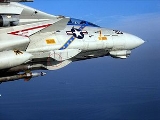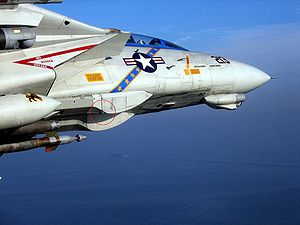
ROVER
Encyclopedia
ROVER, which stands for Remotely Operated Video Enhanced Receiver, is a system which allows ground forces, such as Forward Air Controllers (FAC), to see what an aircraft or unmanned aerial vehicle
(UAV) is seeing in real time by receiving images acquired by the aircraft's sensors on a laptop on the ground. There's little time delay and usage of ROVER greatly improves the FAC on the ground reconnaissance and target identification which are essential to close air support
.
or AC-130 gunships
. The interface was so large it was carried in a HMMWV, but it avoided the long delay of having to call a distant UAV controller and ask what the aircraft was seeing. By fall of 2004, the system's size was reduced to that of a 12 lb device carried in a backpack. ROVER IV plans to include the capability to interface with a wide variety of aircraft and also allow interaction between ground controllers and close air support pilots. With ROVER III, ground controllers have to talk the pilot to the target since they only see the image the aircraft transmits. ROVER IV seeks to use GPS and other systems to allow the controller to click a target they would like the aircraft to engage or the UAV operator to focus on. ROVER is compatible with UAVs and aircraft carrying the LITENING targeting pod
as well as other targeting systems.
 ROVER III capability was added to the F-14D Super Tomcat during its last deployment. It was first used by VF-31
ROVER III capability was added to the F-14D Super Tomcat during its last deployment. It was first used by VF-31
and VF-213
on their last cruise with the F-14 Tomcat
in 2005 and 2006. Within days of the modification teams arrival on the USS Theodore Roosevelt (CVN-71)
all F-14 Tomcats had complete ROVER capability. Before ROVER, ground controllers had to rely on "visual talk-ons" to hunt enemy ground forces and would use a map to guide pilots where they needed to go. A joint VF-31/VF-213 investigation revealed that it would be possible to modify the F-14D Super Tomcat with off-the-shelf technology for only $800 dollars per aircraft.
A team of F-14D experts from the Naval Air Systems Command
(NAVAIR) F-14 Program Office (PMA-241) staff at Naval Air Station Patuxent River
was presented with this idea in early November 2005 and were able to research, develop and field this technology within a six-week window. Northrop Grumman
employees from Naval Air Station Oceana
and members of the fleet support team from Naval Air Systems Command Depot at Naval Air Station Jacksonville
performed the aircraft modification.
F/A-18 Hornets from VFA-25
, VFA-113
, VFA-22
and VFA-115
were also modified with ROVER capability for the first deployment of the USS Ronald Reagan
in 2006.
Sniper ATP targeting pod also uses the ROVER for ground station
Unmanned aerial vehicle
An unmanned aerial vehicle , also known as a unmanned aircraft system , remotely piloted aircraft or unmanned aircraft, is a machine which functions either by the remote control of a navigator or pilot or autonomously, that is, as a self-directing entity...
(UAV) is seeing in real time by receiving images acquired by the aircraft's sensors on a laptop on the ground. There's little time delay and usage of ROVER greatly improves the FAC on the ground reconnaissance and target identification which are essential to close air support
Close air support
In military tactics, close air support is defined as air action by fixed or rotary winged aircraft against hostile targets that are close to friendly forces, and which requires detailed integration of each air mission with fire and movement of these forces.The determining factor for CAS is...
.
ROVER system
The initial ROVER system, ROVER I, was developed in 2002 to allow ground forces to view video feeds from Predator UAVsRQ-1 Predator
The General Atomics MQ-1 Predator is an unmanned aerial vehicle used primarily by the United States Air Force and Central Intelligence Agency...
or AC-130 gunships
Lockheed AC-130
The Lockheed AC-130 gunship is a heavily-armed ground-attack aircraft variant of the C-130 Hercules transport plane. The basic airframe is manufactured by Lockheed, while Boeing is responsible for the conversion into a gunship and for aircraft support...
. The interface was so large it was carried in a HMMWV, but it avoided the long delay of having to call a distant UAV controller and ask what the aircraft was seeing. By fall of 2004, the system's size was reduced to that of a 12 lb device carried in a backpack. ROVER IV plans to include the capability to interface with a wide variety of aircraft and also allow interaction between ground controllers and close air support pilots. With ROVER III, ground controllers have to talk the pilot to the target since they only see the image the aircraft transmits. ROVER IV seeks to use GPS and other systems to allow the controller to click a target they would like the aircraft to engage or the UAV operator to focus on. ROVER is compatible with UAVs and aircraft carrying the LITENING targeting pod
LITENING targeting pod
The AN/AAQ-28 LITENING targeting pod is a precision targeting pod system currently operational with a wide variety of combat aircraft. LITENING significantly increases the combat effectiveness of the aircraft during day, night and under-the-weather conditions in the attack of ground and air...
as well as other targeting systems.
US Navy usage

VF-31
VFA-31 or Strike Fighter Squadron 31 is known as the Tomcatters, callsign "Felix", a United States Navy strike fighter squadron stationed at Naval Air Station Oceana flying the F/A-18E Super Hornet.-Squadron insignia and nickname:...
and VF-213
VFA-213
Strike Fighter Squadron 213 Black Lions is an aviation unit of the United States Navy based at Naval Air Station Oceana, Virginia . It was established in 1955 and is currently equipped with the Boeing F/A-18F Super Hornet...
on their last cruise with the F-14 Tomcat
F-14 Tomcat
The Grumman F-14 Tomcat is a supersonic, twin-engine, two-seat, variable-sweep wing fighter aircraft. The Tomcat was developed for the United States Navy's Naval Fighter Experimental program following the collapse of the F-111B project...
in 2005 and 2006. Within days of the modification teams arrival on the USS Theodore Roosevelt (CVN-71)
USS Theodore Roosevelt (CVN-71)
USS Theodore Roosevelt is the fourth Nimitz-class supercarrier. Her radio call sign is Rough Rider, the name of President Theodore Roosevelt's volunteer cavalry unit during the Spanish-American War...
all F-14 Tomcats had complete ROVER capability. Before ROVER, ground controllers had to rely on "visual talk-ons" to hunt enemy ground forces and would use a map to guide pilots where they needed to go. A joint VF-31/VF-213 investigation revealed that it would be possible to modify the F-14D Super Tomcat with off-the-shelf technology for only $800 dollars per aircraft.
A team of F-14D experts from the Naval Air Systems Command
Naval Air Systems Command
The Naval Air Systems Command provides material support for aircraft and airborne weapon systems for the United States Navy. NAVAIR was established in 1966 as the successor to the Navy's Bureau of Naval Weapons . Current Commander, Naval Air Systems Command, is Vice Adm. David Architzel since May...
(NAVAIR) F-14 Program Office (PMA-241) staff at Naval Air Station Patuxent River
Naval Air Station Patuxent River
"Pax River" redirects here. For the river, see Patuxent River.Naval Air Station Patuxent River , also known as NAS Pax River, is a United States Naval Air Station located in St. Mary's County, Maryland on the Chesapeake Bay near the mouth of the Patuxent River. It is home to the U.S...
was presented with this idea in early November 2005 and were able to research, develop and field this technology within a six-week window. Northrop Grumman
Northrop Grumman
Northrop Grumman Corporation is an American global aerospace and defense technology company formed by the 1994 purchase of Grumman by Northrop. The company was the fourth-largest defense contractor in the world as of 2010, and the largest builder of naval vessels. Northrop Grumman employs over...
employees from Naval Air Station Oceana
Naval Air Station Oceana
Naval Air Station Oceana or NAS Oceana is a military airport located in Virginia Beach, Virginia, and is a United States Navy Master Jet Base. It is also known as Apollo Soucek Field, named after Lieutenant Apollo Soucek, a Navy Test Pilot who set the global altitude record in 1930 by flying a...
and members of the fleet support team from Naval Air Systems Command Depot at Naval Air Station Jacksonville
Naval Air Station Jacksonville
Naval Air Station Jacksonville or NAS Jacksonville is a military airport located four miles south of the central business district of Jacksonville...
performed the aircraft modification.
F/A-18 Hornets from VFA-25
VFA-25
Strike Fighter Squadron 25 is a United States Navy strike fighter squadron based at NAS Lemoore. Its current tail code is AA, its callsign is Fist, and it flies the F/A-18C Hornet.-Squadron insignia and nickname:...
, VFA-113
VFA-113
Strike Fighter Squadron 113 Stingers is a United States Navy strike fighter squadron based at Naval Air Station Lemoore, California....
, VFA-22
VFA-22
VFA-22, Strike Fighter Squadron 22, also known as the "Fighting Redcocks", are a United States Navy F/A-18F Super Hornet fighter squadron stationed at Naval Air Station Lemoore...
and VFA-115
VFA-115
Strike Fighter Squadron 115 , also known as the "Eagles", is a United States Navy F/A-18E Super Hornet fighter squadron stationed at Naval Air Facility Atsugi...
were also modified with ROVER capability for the first deployment of the USS Ronald Reagan
USS Ronald Reagan (CVN-76)
USS Ronald Reagan is a Nimitz-class nuclear-powered supercarrier in the service of the United States Navy. The ninth ship of her class, she is named in honor of former President Ronald Reagan, President of the United States from 1981 to 1989...
in 2006.
Sniper ATP targeting pod also uses the ROVER for ground station
External links
- ROVER System Revolutionizes F-14's Ground Support Capability
- ROVER adds extra set of eyes to sky - Usage in Raven UAV
- ROVER Sics TacAir on America's Enemies - Discusses original ROVER usage in UAVs and targeting pods.
- Warner Robins Air Logistics Center - FY2002 - High Technology - Historical account of the rapid deployment of ROVER capability to AC-130's during Operation Enduring Freedom
- US Pilot Helped Clear the Fog of War - LA Times account of how ROVER was championed and adopted by the various services in Iraq and Afghanistan

